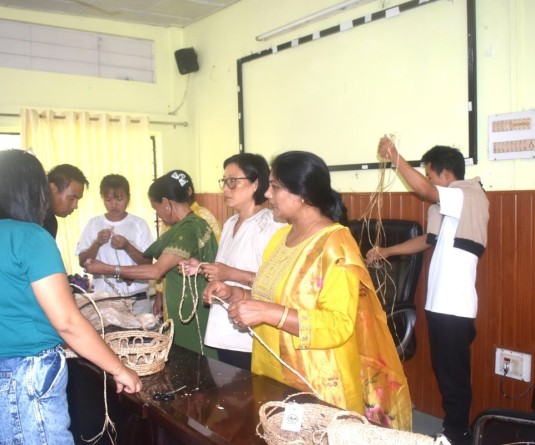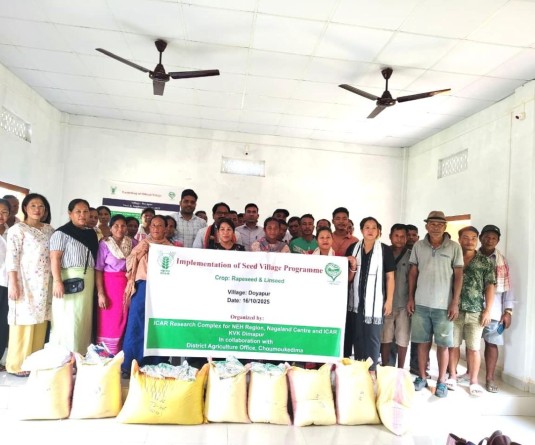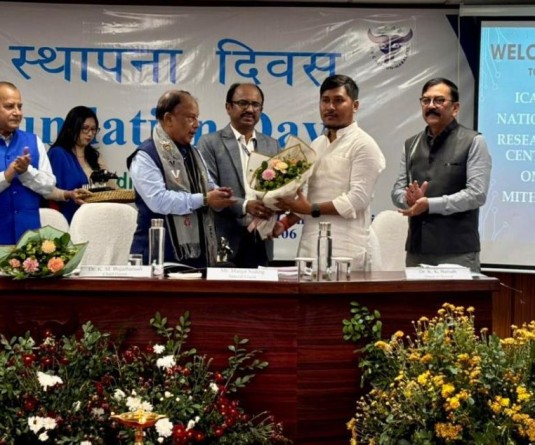
Tolika Swu, Christy BK Sangma & LK Baishya
ICAR Nagaland Centre, Medziphema
A weed is a plant considered undesirable in a particular situation, "a plant in the wrong place". According to a study by researchers associated with the Indian Council for Agricultural Research (ICAR), India loses agricultural produce worth over $11 billion annually due to weeds, which is more than the Centre’s budgetary allocation for agriculture for the year 2017-18. One such weed species, “Parthenium hysterophorus L.”, since the last few years has emerged as the seventh most devastating weed in Africa, Asia and Australia. This is a weed of global significance responsible for many human and animal health issues, such as dermatitis, asthma and bronchitis, and agricultural losses besides a great problem for biodiversity. The spread of seeds plus their ability to remain viable in the soil for many years pose one of the most complex problems for control. In India, P. hysterophorus causes yield decline of up to 40% in agricultural crops (Khosla and Sobti 1981). Efforts made across the world to find persistent methods of controlling Parthenium by way of mechanical, chemical, or biological means, have at best achieved only partially and temporarily. Thus, finding an ecologically sound and economically viable means by which Parthenium can be gainfully utilized in large quantities, appears to be the only approach which can make it profitable while at the same time keeping the weeds under control.
Composting of Parthenium is another useful alternative to convert this weed to a useful material that can be used as a soil conditioner. Composting is not a new technology, but amongst the waste management strategies it is gaining interest as a suitable option for manures and also serves as a dual purpose of eradication of the weeds by better utilization as compost for crop production and as well as a good source of employment and income to farmers. The compost from Parthenium will also act as a recycling of nutrients that are sucked by undesired plant from the soil. Presently, the available methods take a long time in preparing Parthenium compost which is less eco-friendly. As a result, a method and recipe have been developed for preparing compost of Parthenium in comparatively less time (60 days only) and it has been named as “Vishishta” composting. The term ‘Vishishta’ is a Hindi word, which means ‘something special’. Quantity of matured compost obtained by this method is greater than other methods and it is also suitable for destroying the weed seeds during the composting process.

Methodology for preparation
The collected Parthenium plants are cut into small pieces (max size <2.5cm) and kept in plastic bags for 2–3 days under the direct sunlight. When these are opened for composting process, the materials are hot enough. Along with Parthenium, other materials are used for different purposes, e.g.
Rock phosphate is used to reduce the time of decomposition and to obtain more nutrient rich compost.
Sawdust on the other hand traps the heat better within the pile because of its insulating properties and also it is a good source of carbon, thus providing a balance to the required C/N ratio.
Wheat straw and dry fallen leaves are used as a good source of carbon for maintaining the required C/N ratio in the process.
Likewise, other organic wastes such as cow dung and cow dung ash are used so that the waste could be utilized and more balanced compost could be prepared.
Design and process of preparation
A wooden box of size 90 cm×90 cm×90 cm is prepared and used as a bin for composting (Fig 1). Many holes are made on all the four sides of the box providing a proper passage of air in the box. The base and upper parts of the box are kept hollow so that it can be easily detached from the material while turning is provided to the material. A base of the plastic cover is made and the box is placed over it. All the collected materials such as Parthenium weed, sawdust, rock phosphate, cow dung ash, dried fallen leaves, wheat straw and T. viride fungi culture powder are mixed in the desired proportions and placed in the bin. A solution of cow dung is prepared using water. It is sprinkled timely on the material during filling material in the bin so as to provide appropriate moisture content. Then, the box is covered with a plastic cover for protecting it from intense sun light, rain as well as from predators. This material is kept undisturbed for 3 days. Only water is sprinkled in it in desired quantity to make optimum moisture content during this phase. Temperature is monitored regularly in the pile at around 65°C on the 3rd day, which is optimum for composting process. Hence, it is turned over so that it could be protected from overheating. Therefore, after 3 days, the first turning is provided to the material. While turning the material in the pile, some positive signs of composting is observed, such as the material becomes dark in colour, becomes hot and some fumes are visible even with naked eyes. Turning is provided to the material regularly on alternate days for 1 month. After 1 month, the frequency of turning is reduced to 4–5 turnings in a month with an interval of 7–8 days. It reduces labour and also provides the desired optimum temperature. A total of 16–17 turnings are provided in the whole process in 2 months for composting Parthenium weed with other organic wastes, rock phosphate and T. viride. Water is sprinkled regularly for maintaining moisture content. A few days after initial turnings, a white fungal appearance is also seen on turning the compost (Fig 2), which may be a possible cause of degradation of feedstock in shorter duration. Thus, 60% of the feedstock is obtained as compost in 60 days through Vishishta composting. When composting process is completed; sampling of the compost is done.
Product- matured compost
In the present experiment, Parthenium weed was composted in an environmental friendly way within 2 months only. The nutritional status of the prepared compost is also satisfactory as compared to other manures as it has 2–3 times more nitrogen than FYM (well decomposed FYM contains 0.5% nitrogen, 0.2% phosphorus and 0.5% potassium) (Prem et al., 2010). When the compost was applied to the field to the desired crops, Parthenium plant germination should not be seen in the field, which is a good sign that Parthenium seeds are destroyed during the process. Thus, an eco-friendly method and recipe have been developed for composting Parthenium weed, with the addition of different organic wastes in shortest duration as compared to earlier methods available till today.

Benefits
1. Control of weed population
2. Reduced use of chemical fertilizers
3. Giving nutrients back to the desired crop
4. Environmental friendly approach which is quite necessary in the present scenario
5. No harmful effects on crops, human beings and environment
Conclusion
In the present scenario, everyone is talking about utilizing the resources in an environment friendly way for maintaining long-term sustainability of our planet Earth. Nowadays, many areas are already facing lack of availability of adequate food supply because of extreme population pressure and imbalanced weather phenomenon. Weeds are also contributing in all these and thus, enhancing this problematic status. Therefore, such weeds need to be properly managed and one such way is to turn these problematic weeds into useful compost.






